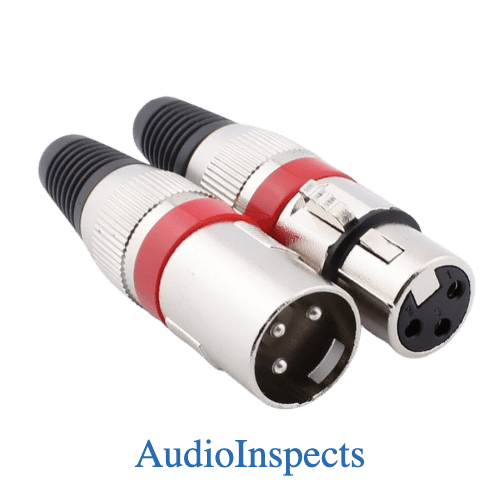What Are XLR Connectors and What Are They Used For?

We conduct independent testing and research of products, so you can make an informed decision before making a purchase. And when you do decide to make a purchase through our links, please note that we may earn a commission, but this does not affect the honesty of our reviews.
XLR connectors are a type of electrical connector used in audio, video, and other electronic equipment. Since the late 1950s, they become the industry-standard connectors for a reason and have been used to join microphones, speakers, amplifiers, and other audio gadgets.
XLR connectors are popular because they provide secure connections with excellent noise-rejection properties that make them suitable for use in professional audio applications.
XLR connectors come in a range of sizes and shapes, making them ideal for various cables or applications. What’s more, they have an easy-to-use locking system that deters any accidental detachment while it is being used.
With such versatility and reliability, it’s no wonder why XLR connectors remain one of the most popular types of audio/video connection available today!
What Are XLR Connectors?
XLR connectors are a type of electrical connector that is commonly used in professional audio and video equipment. They are named after the eXtra Low Resistance that they offer, making them ideal for balanced audio applications that require interference-free signals.
XLR connectors stand out for their unparalleled versatility, enabling them to be used in a plethora of situations from microphones, to line-level signals, speakers, and mixers. This is thanks to the different configurations of pins that they offer, including 3-pin and 5-pin variations.
Moreover, XLR connectors are known for their durability and reliability. These connectors are engineered to offer a dependable and secure connection that is built for heavy-duty use. Additionally, they provide excellent shielding, which helps to eliminate interference and noise.
XLR connectors offer unparalleled convenience. Unlike other types of plugs that require specific techniques or tools to attach, with these you simply twist and lock them in place securely – it’s as easy as one two three! Additionally, they come in both male and female versions which renders them practical for any type of use.
What Is An XLR Cable Used For?
An XLR cable is used to transmit balanced audio signals. It is commonly used in audio recording and live sound reinforcement settings, as well as in professional video production.
XLR cables are preferred for their ability to reject electromagnetic interference and their high signal fidelity, which makes them ideal for critical audio applications where noise and interference can be problematic. They are a reliable and popular choice for connecting microphones, mixers, amplifiers, and other audio equipment.
A few examples of equipment that commonly use XLR cables:
- Microphones, both dynamic and condenser, typically use XLR cables to connect to a mixing console, audio interface, or other equipment.
- Mixing consoles and audio interfaces often feature XLR inputs and outputs to facilitate the connection of microphones and other audio sources.
- Amplifiers and powered speakers also commonly use XLR cables to connect to audio sources such as mixing consoles or audio interfaces.
- Professional video equipment, such as cameras and field recorders, often use XLR connectors for their audio inputs, to facilitate high-quality audio recording.
Types of XLR Connectors
XLR connectors come in a variety of sizes and configurations, to suit different applications. The most common type of XLR connector is the 3-pin variety. This is the standard configuration that is used for most microphone and line-level applications.
The 5-pin XLR connector is also commonly used for connecting microphones, as well as more advanced audio applications such as multi-channel recording.
For higher-level applications, such as connecting speakers to amplifiers, 4-pin, and 6-pin XLR connectors are available.
3-Pin XLR Connectors (XLR3)

Of all XLR connectors, the 3-pin version is by far the most popular and widely used. It features three pins wired in a TRS (tip, ring, sleeve) configuration, with the tip and ring connected to a twisted pair of wires for balanced audio signals.
The 3-pin XLR connector is the leading choice for professional sound settings, due to its capacity to transmit balanced audio signals with unparalleled accuracy. The balanced audio signal reduces noise and interference by canceling out any unwanted signals that may be picked up along the cable.
The 3-pin XLR connector is a must for professional audio gear due to its unfailing sturdiness and strength, making it ideal even in the toughest of conditions. It features a secure locking mechanism that prevents accidental disconnection or damage to the cable, ensuring a reliable and consistent connection.
The 3-pin XLR connector also offers great versatility, as it can be used for both microphones and line-level audio sources such as mixers and interfaces. Its TRS configuration with the tip and ring connected to a twisted pair of wires further enhances its versatility by allowing it to carry both audio signals and DC power.
Boasting exceptional versatility and durability, the 3-pin XLR connector is a top pick for professional audio engineers who rely on its ability to transmit superior quality balanced sound signals with minimal noise or disturbances.
4-Pin XLR Connectors (XLR4)

The 4-pin XLR connector is a common intercom connection used by many professional voice actors. It’s a standard connection for intercom headsets. This cable features a female plug on one end and a male XLR plug on the opposite side.
The plug is a standard XLR plug that’s been designed for professional audio applications. The 4-pin XLR plug provides balanced audio signals. You can connect a microphone to an amplifier.
Like the 3-pin XLR connector, it provides balanced audio signals that reduce noise and interference for high-quality audio transmission.
The 4-pin XLR connector offers unparalleled versatility compared to other connectors, making it a must-have for any audio professional or enthusiast. It can be used to connect not only microphones to amplifiers but also intercom headsets to audio equipment. This is important for professionals who require a reliable and consistent connection for clear communication during performances.
Moreover, the 4-pin XLR connector is equipped with a secure locking mechanism to protect from accidental disconnection or destruction of the cable. This ensures the consistent and reliable performance that professionals need in demanding audio applications.
Furthermore, the 4-pin XLR connector is built to withstand heavy-duty use in professional audio equipment. Its robustness and dependability make it a must-have for professionals who expect top-notch equipment that can endure the strains of day-to-day usage in any given environment.
In summary, the 4-pin XLR connector offers versatility, reliability, and durability that meet the demands of professionals in the audio industry. Its ability to provide high-quality balanced audio signals, along with its secure locking mechanism, make it an excellent choice for a range of audio applications, including intercom connections for voice actors.
5-Pin XLR Connectors (XLR5)

5-pin XLR connectors are commonly used in professional audio applications, such as mixing consoles, studio monitors, and professional intercoms. It provides two balanced audio signals and common ground.
The XLR connector has five pins: two signal wires (the tip and ring), a ground wire, and a shielding wire. It is designed for a balanced audio signal.
XLR connectors are usually terminated with a male plug and a female socket. The female socket is often called a “plug” or a “jack”.
FAQs
Conclusion
Ultimately, XLR connectors are a sound choice for any audio or video professional. Not only are they dependable and versatile but also incredibly user-friendly! Whether you are a musician, sound engineer, or video professional, you can rely on XLR connectors to provide high-quality, interference-free signals that meet your needs.
Our Mission: At AudioInspects, we are dedicated to providing the most comprehensive and authentic reviews of audio equipment on the market. We conduct independent testing and research of products, so you can make an informed decision before making a purchase. Our mission is to help you find the best audio equipment to improve your listening experience. So trust us to deliver the most reliable recommendations and advice.
Disclosure: When you do decide to make a purchase through our links, please note that we may earn a commission, but this does not affect the honesty of our reviews. You can read our affiliate disclosure in our Disclosure.


![Home Theatre Power Managers Explained [10 Best Reviewed]](https://audioinspects.com/wp-content/uploads/2022/05/red-home-cinema-system-2021-08-26-15-32-53-utc-768x415.jpeg)